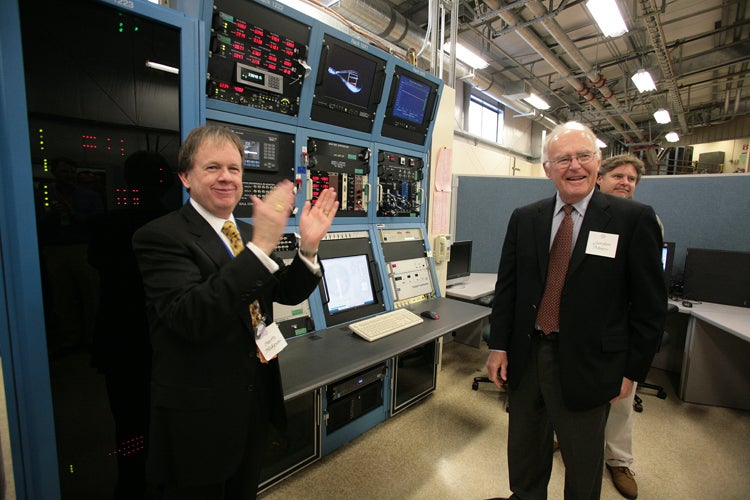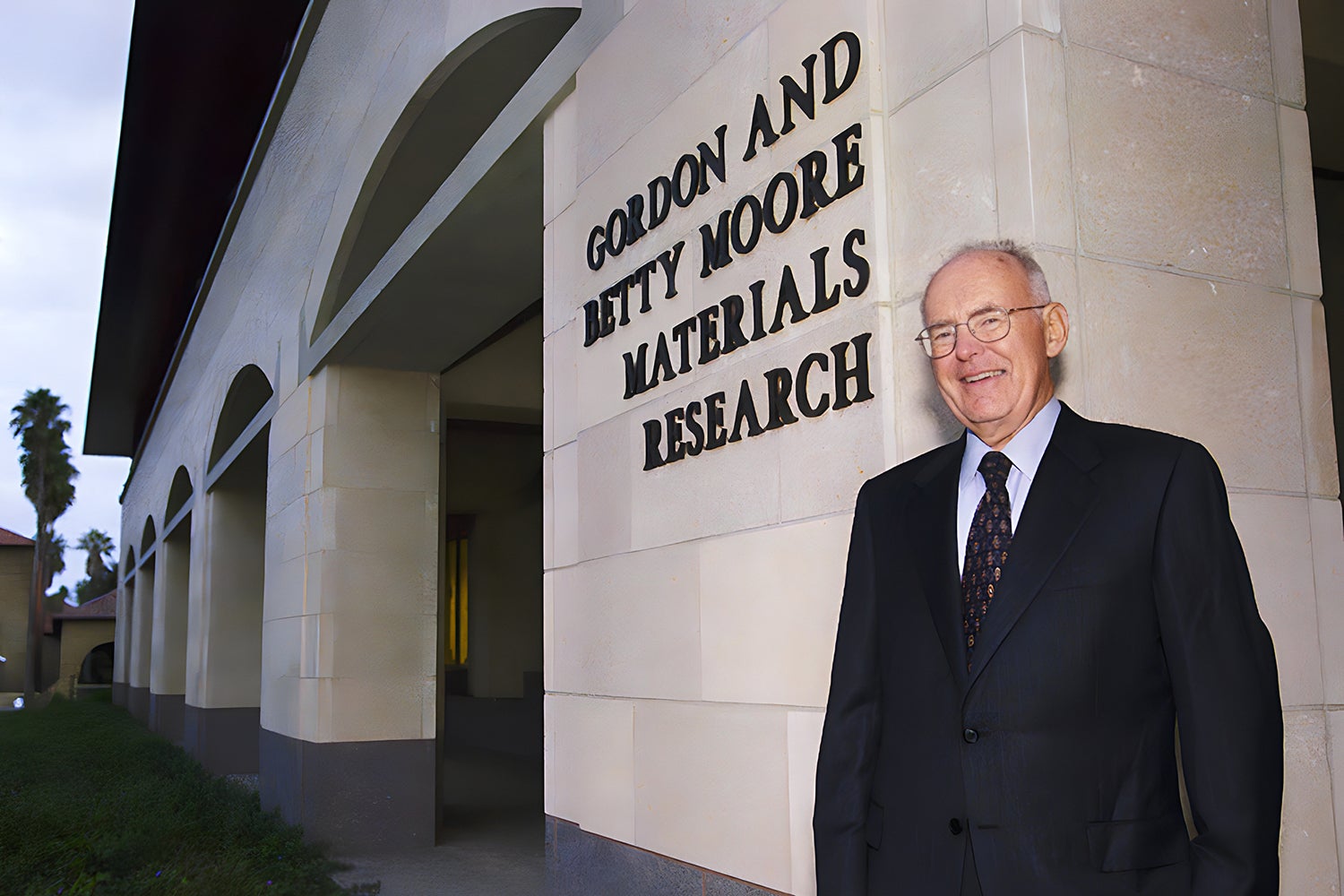Keith Hodgson recalls sitting across a table from Gordon Moore in October 2003. Then director of the Stanford Synchrotron Radiation Lightsource, Hodgson and his counterpart Doug Rees at Caltech were seeking support for a new state-of-the-art beam line at SSRL, with a remote satellite facility at Caltech. The goal was to build a “molecular observatory” enabling forefront research to illuminate some of the most challenging questions in structural biology.

Keith Hodgson (left) joined Gordon Moore (center) and beamline scientist Mike Soltis at the dedication of the Molecular Observatory in 2007. (Image credit: SLAC National Accelerator Laboratory)
Securing funding for such a cutting-edge instrument can take years, Hodgson says, and longer still to get things built. But not with Moore, the legendary Silicon Valley entrepreneur and philanthropist.
“Within weeks we had an answer – Moore would give us the $15 million to build that Molecular Observatory. By 2008, it was operational,” says Hodgson. “That timeline would not have been possible without Gordon Moore. That’s how he worked. Once he understood the science and the potential, he moved quickly.”
Gordon Earle Moore died March 24 at his home in Hawaii at the age of 94. Though he was not a graduate of the university, over a four-decade history of giving he and his wife, Betty, built a record of transformative philanthropy at Stanford that those who knew him say will be difficult to equal.
“Gordon Moore had the highest achievement-to-humility ratio of anyone I ever met,” said John L. Hennessy, who served as Stanford University president from 2000 to 2016 and has served on the Board of Trustees of the Gordon and Betty Moore Foundation since 2012. “He was a scientist and believed deeply in science. He invested in the things he believed could make a major difference, whether that was frontier investigation of new materials, supporting transformative conservation, improving patient care, or developing the next generation of scientists and engineers.”
A focus on ‘areas of higher impact’
Together, the Moores founded the Gordon and Betty Moore Foundation in 2000 with a stake of more than $5 billion of Intel stock. Their philanthropic interests were many, but all were grounded in a fundamental faith in science and a desire for lasting impact.
In the Statement of Founders’ Intent on the Moore Foundation’s website, the couple laid out their philosophy: “Scientific methodology should be a cornerstone of nearly all of the foundation’s efforts.”
Most gifts to Stanford were made through the foundation and largely aimed at advancing its main areas of focus: the physical and environmental sciences, patient care improvements, and environmental conservation. But the foundation was only the most outwardly visible example of the Moores’ philanthropy. Many gifts came from their personal fortune. Often, they were made quietly.

Gordon Moore and his wife, Betty, made notable contributions across the physical sciences and engineering at Stanford, including the naming gift for the Gordon and Betty Moore Materials Research Building. (Image credit: Steve Castillo)
Gordon Moore’s first gift to Stanford, made in 1982, supported the School of Engineering’s Center for Integrated Systems (CIS), now known as the Stanford SystemX Alliance. In 1997, he and his wife made the naming gift for the Gordon and Betty Moore Materials Research Building, home to some of the most important progress in the field of advanced materials.
The Moore Foundation has built on those early gifts, making notable contributions across the physical sciences and engineering at Stanford, including multiple investigator awards through its Emergent Phenomena in Quantum Systems Initiative and significant grants for development of high-potential enabling tools and technologies such as a quantum electron microscope, a new device for detecting gravitational waves, and an accelerator on a chip.
Several Stanford faculty members have been named Moore Inventor Fellows – a program that honors Moore’s own history as a scientist-inventor – winning support to develop early-stage ideas such as a device to rapidly identify proteins in cells accurately. Through its grantmaking in science learning, the foundation has sought to foster Moore’s own passion for science and conservation among young people by funding work at Stanford ranging from making the low-cost paper Foldscope accessible to teachers and children around the globe to pioneering the use of virtual reality for environmental education.
Over the course of 40 years, the Moores’ personal gifts expanded to other areas of the university, providing support for the School of Humanities and Sciences, where they established a fellowship fund; the Kavli Institute for Particle Astrophysics and Cosmology; the Knight-Hennessy Scholars program; the Hoover Institution; and the Stanford Institute for Economic Policy Research, where Gordon Moore served as a member of its advisory board for many years.
In human health, he and Betty made gifts for Stanford Medicine’s Biomedical Innovations Building, the Transforming Patient Care Initiative for the Cancer Care Center, the Clinical Excellence Research Center, and a faculty scholar. To improve the care of children with heart disease, the couple established the Betty Irene Moore Children’s Heart Center at the Lucile Packard Children’s Hospital Stanford in 2017.
“Basic science and innovation are critical to advancing pediatric heart health and surgery,” recalls Frank Hanley, chief of pediatric cardiac surgery at the Betty Irene Moore Children’s Heart Center. “The Moores understood this implicitly. One New Year’s Eve we received a letter without fanfare: The Moores would invest $50 million in the Heart Center.”
Included was a handwritten check for the first installment.
A giving nature
An indefatigable fisherman, and lover of the ocean and nature more broadly – and as a native of the San Francisco Bay Area – Moore provided major funding for environmental research at Stanford and elsewhere along the Central Coast. In particular, he supported the Natural Capital Project and several projects of the Stanford Woods Institute for the Environment, the Center for Ocean Solutions, and Hopkins Marine Station.
Rob Dunbar, a professor of oceans and of Earth system science at the Stanford Doerr School of Sustainability, first met Moore in 2004 when Dunbar was helping to create a research consortium and build a research station at Palmyra Atoll, an island in the central Pacific that Moore had helped the Nature Conservancy acquire in 2000 for coral reef research and conservation.
Dunbar got to know Moore well on flights back and forth to Palmyra and while on the island. As soon as the cabins of the research station were built, Dunbar led a series of three donor trips to the atoll – Gordon Moore was on all three.
“I recall Gordon reading Science magazine cover to cover,” Dunbar says. “His interests in science and engineering were incredibly broad, and it didn’t take many questions to realize he kept abreast of the latest breakthroughs in global science in many disciplines.”
In the subsequent 20 years, the Palmyra research station would generate important insights into how coral reefs function, and how to protect them and other tropical island ecosystems.
In Moore, a deep love of nature, an abiding trust in science, and a genuine compassion for others united in a legacy of good deeds that will endure for a long time to come.
“Stanford is a better university due to Gordon Moore’s vision and his generosity,” said former president Hennessy.
Hodgson is the David Mulvane Ehrsam and Edward Curtis Franklin Professor of Chemistry, a professor of photon science at the U.S. Department of Energy’s SLAC National Accelerator Laboratory, a faculty fellow at Sarafan ChEM-H, and a member of Stanford Bio-X. Hennessy is the Shriram Family Director of the Knight-Hennessy Scholars Program and the James F. and Mary Lynn Gibbons Professor at the School of Engineering. Hanley is the Lawrence Crowley, MD, Endowed Professor of Child Health and a member of the Cardiovascular Institute and Maternal & Child Health Research Institute. Dunbar is the W. M. Keck Professor in the Stanford Doerr School of Sustainability, a senior fellow at the Stanford Woods Institute for the Environment, and a member of Stanford Bio-X.